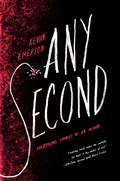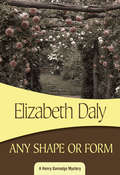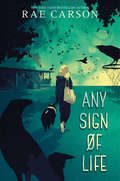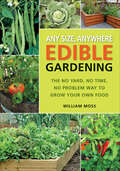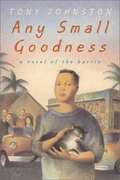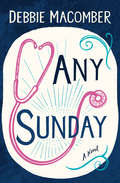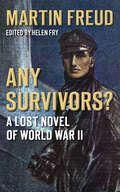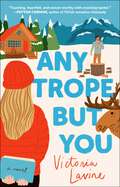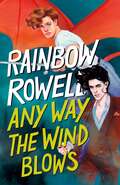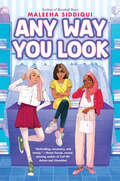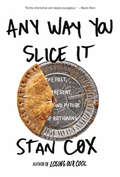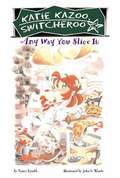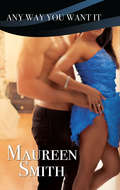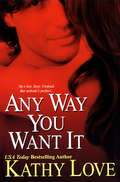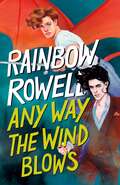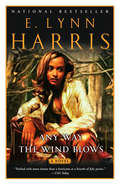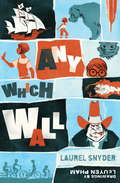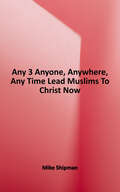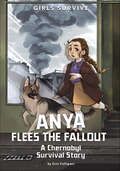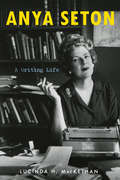- Table View
- List View
Any Rogue Will Do (Misfits of Mayfair #1)
by Bethany BennettIn a "splendid Regency-set debut" for fans of bestselling authors Sarah MacLean, Lenora Bell, and Kerrigan Byrne, the rogue who once ruined Lady Charlotte's reputation is now the only one who can save her (Publishers Weekly, Starred Review).For exactly one season, Lady Charlotte Wentworth played the biddable female the ton expected -- and all it got her was society's mockery and derision. Now she's determined to be in charge of her own future. So when an unwanted suitor tries to manipulate her into an engagement, she has a plan. He can't claim to be her fiancé if she's engaged to someone else. Even if it means asking for help from the last man she would ever marry. Ethan, Viscount Amesbury, made a lot of mistakes, but the one he regrets the most is ruining Lady Charlotte's reputation. Going along with her charade is the least he can do to clean the slate and perhaps earn her forgiveness. Pretending to be in love with the woman he's never forgotten is easy. What isn't easy is convincing her to give him a second chance.
Any Second
by Kevin EmersonMarieke Nijkamp's This is Where it Ends meets Kathleen Glasgow's Girl in Pieces in a gripping novel that explores the depths of trauma and the strength it takes to rise again. Perfect for readers of Ellen Hopkins.Five years after being kidnapped, Elian's captor sends him into the mall--with a bomb strapped to his chest.Across the mall is Maya, a girl whose crippling anxiety holds her prisoner in its own way. Whether it's chance or fate, Maya keeps Eli from ending them all. And now nothing is the same. Drawn together by their dark pasts, Maya and Eli know it takes only seconds for their entire worlds to change. But time will tell if meeting each other will change them for better or worse."A riveting novel about the capacity for hope in the midst of evil." - Sara Zarr, National Book Award finalist
Any Shape or Form (Henry Gamadge #9)
by Elizabeth DalyFrom Agatha Christie’s favorite American author—a bookish sleuth attempts to solve the murder of a spiritual eccentric at a wealthy estate.Just about any of the guests at Johnny Redfield’s party seems to have a good reason to have killed the guest of honor, Johnny’s Californian aunt who, with her astral name and vague pretensions of mysticism, does not exactly blend in the elegant New York atmosphere that surrounds her. And what’s more, no one has a solid alibi. It will take all of Henry Gamadge’s ingenuity to figure out this closed-room mystery.
Any Sign of Life
by Rae Carson“Any Sign of Life is a heartbreaking story filled with courage, friendship, and personality. Paige Miller is the perfect team-up buddy in an apocalypse. I was with her when she lost everything, and stood right next to her when she took it all back.”—Wesley Chu, #1 New York Times–bestselling author of the War Arts SagaWhen a teenage girl thinks she may be the only person left alive in her town—maybe in the whole world—she must rely on hope, trust, and her own resilience. A harrowing and pulse-pounding survival story from New York Times–bestselling author Rae Carson. Any Sign of Life is a must-have for readers of Rick Yancey’s The 5th Wave and Neal Shusterman and Jarrod Shusterman's Dry.Paige Miller is determined to take her basketball team to the state championship, maybe even beyond. But as March Madness heats up, Paige falls deathly ill. Days later, she wakes up attached to an IV and learns that the whole world has perished. Everyone she loves, and all of her dreams for the future—they’re gone.But Paige is a warrior. She pushes through her fear and her grief and gets through each day scrounging for food, for shelter, for safety. As she struggles with her new reality, Paige learns that the apocalypse did not happen by accident. And that there are worse things than being alone.New York Times–bestselling author Rae Carson tells a contemporary and all-too-realistic story about surviving against the odds in this near-future thriller. Any Sign of Life will electrify fans of Rory Power’s Wilder Girls and Emily St. John Mandel’s Station Eleven.
Any Size, Anywhere Edible Gardening: The No Yard, No Time, No Problem Way To Grow Your Own Food
by William MossFrom the host of HGTV’s Dig In: “If you live in limited quarters, are just starting out, and want to grow most-likely-to-succeed plants, have a read.” —The Philadelphia InquirerEdibles continue to be popular choices for gardeners, and beginning gardeners are no exception. Author William Moss takes a beginning gardener through all the steps needed to grow vegetables and fruits in any setting, regardless of the available (or desired) size. This book covers container gardening, vertical gardening, raised-bed gardening, and traditional methods to help gardeners everywhere bring a taste of homegrown freshness to their gardening experience.“Moss offers ideas for finding space to garden, techniques for creating and maintaining gardens and basic growing information. The bulk of the book, however, is dedicated to details about plants that grow well in compact spaces, with an entire chapter devoted to that all-time favorite, the tomato.” —Akron Beacon Journal“Besides the usual how-to information, Moss offers a chapter that focuses on different types of small gardens, ranging from a container or trellis on a balcony to a small backyard or plot in a community garden.” —Country Gardens Magazine
Any Small Goodness: A Novel of the Barrio
by Tony JohnstonThe story is about the family of Arturo, who were the migrants from Mexico to Los Angeles, finding difficult to cope with the new culture while maintaining the old one.
Any Sunday: Jury Of His Peers Any Sunday (Debbie Macomber Classics)
by Debbie MacomberA fiercely independent young woman takes a leap of faith by trusting a charming physician in this delightful novel from #1 New York Times bestselling author Debbie Macomber. Marjorie Majors has not been to a doctor since she was fourteen, and she&’d like to keep it that way. As far as she is concerned, she has always been perfectly fine on her own. Marjorie doesn&’t need—or want—anyone to take care of her. But when an unbearable case of appendicitis becomes too much to bear, Marjorie begrudgingly gives in, reluctant as ever. Enter Dr. Sam Bretton, who is just as warm and friendly as he is handsome. It turns out that Sam's bedside manner can inspire confidence in anyone, and as he and Marjorie get to know one another, their friendship clearly has the potential to become something more. Yet Marjorie&’s old defiant ways still linger, and she can&’t help but hesitate to let a man into her heart. Will her stubbornness threaten to end her love story before it has even begun?
Any Survivors?: A Lost Novel of World War II
by Helen Fry Martin FreudIn 2008 a faded typescript was discovered in a suitcase in the attic of one of Martin Freud's grandchildren. It was a satirical novel about the Second World War written by Sigmund Freud's son Martin, but never published and apparently forgotten about. Freud and his family had escaped from Nazi-occupied Vienna in 1938, narrowly avoiding losing everything, including their lives. Arriving in England, Martin, formerly an eminent lawyer in Vienna, was interned as an 'enemy alien,' and later ran a shop near the British Museum (his son, Walter, fought for the British in the SOE during the war). It is known that Martin wrote numerous poems and pieces of fiction, but the only books he ever published were a fictionalised account of his experiences during the First World War, Parole d'Honneur, in 1939 and an autobiography, Glory Reflected, in 1957. Now translated into English and published for the first time, Any Survivors? is not only a satirical and dramatic novel about a refugee who returns to Hitler's Germany as a rather inept spy, but also the testament of a man who lived through the most dramatic moments of this period as part of a famous and fascinating family.
Any Time, Any Place (The Billionaire Builders #2)
by Jennifer ProbstHGTV&’s Property Brothers meets The Marriage Bargain in this second volume in the Billionaire Builders series, an all-new heart-wrenching and sexy contemporary romance from New York Times bestselling author Jennifer Probst.When she was a teen, Raven Bella Stratton’s father was killed in a horrible car crash. The bigger shock was the discovery of a woman with him—Diana Pierce—and their two fully packed suitcases with airline tickets to Paris. Devastated by her father’s betrayal, Raven went to live with her aunt, never truly overcoming the traumatic event. When she discovers that the mysterious woman had a family with a husband and three boys, Raven vows to leave the memory of her father behind. Until Dalton Pierce visits one night and suddenly her past challenges her future... Leaving his life in California behind to run Pierce Construction with his two older brothers, Dalton Pierce has enjoyed returning home and studying his passion of woodworking. But when he visits the local bar with his brothers one evening, he’s immediately drawn to the smart-mouthed, badass, sexy bartender who sets his body on fire. Unfortunately, she doesn’t seem as intrigued by him, and his multiple advances are met with rejection. When he offers to restore the bar back to its original glory, he begins to work with her on a daily basis, and falls harder. His plan of seduction slowly weaves a web around them both, until they are caught up in the spell. But Dalton doesn’t know the secret that can either destroy them both...or finally mend two broken hearts.
Any Trope but You: A Novel
by Victoria LavineA bestselling romance author flees to Alaska to reinvent herself and write her first murder mystery, but the rugged resort proprietor soon has her fearing she&’s living in a rom-com plot instead in this earnestly spectacular debut by a stunning new voice.Beloved romance author Margot Bradley has a dark secret: she doesn&’t believe in Happily Ever Afters. Not for herself, not for her readers, and not even for her characters, for whom she secretly writes alternate endings that swap weddings and babies for divorce papers and the occasional slashed tire. When her Happily Never After document is hacked and released to the public, she finds herself canceled by her readers and dropped by her publisher. Desperate to find a way to continue supporting her chronically ill sister, Savannah, Margot decides to trade meet-cutes for murder. The fictional kind. Probably. But when Savannah books Margot a six-week stay in a remote Alaskan resort to pen her first murder mystery, Margot finds herself running from a moose and leaping into the arms of the handsome proprietor, making her fear she&’s just landed in a romance novel instead. The last thing Dr. Forrest Wakefield ever expected was to leave his dream job as a cancer researcher to become a glorified bellhop. What he&’s really doing at his family&’s resort is caring for his stubborn, ailing father, and his puzzle-loving mind is slowly freezing over—until Margot shows up. But Forrest doesn&’t have any room in his life for another person he could lose, especially one with a checkout date. As long snowy nights and one unlikely trope after another draw Margot and Forrest together, they&’ll each have to learn to overcome their fears and set their aside assumptions before Margot leaves—or risk becoming a Happily Never After story themselves.
Any Way The Wind Blows (Simon Snow Trilogy #3)
by Rainbow RowellNew York Times bestselling author Rainbow Rowell's epic fantasy, the Simon Snow trilogy, concludes in Any Way the Wind Blows. <P><P> In Carry On, Simon Snow and his friends realized that everything they thought they understood about the world might be wrong. And in Wayward Son, they wondered whether everything they understood about themselves might be wrong. <P><P> In Any Way the Wind Blows, Simon and Baz and Penelope and Agatha have to decide how to move forward. <P><P> For Simon, that means deciding whether he still wants to be part of the World of Mages ― and if he doesn't, what does that mean for his relationship with Baz? Meanwhile Baz is bouncing between two family crises and not finding any time to talk to anyone about his newfound vampire knowledge. Penelope would love to help, but she's smuggled an American Normal into London, and now she isn't sure what to do with him. And Agatha? Well, Agatha Wellbelove has had enough. <P><P> Any Way the Wind Blows takes the gang back to England, back to Watford, and back to their families for their longest and most emotionally wrenching adventure yet. <P><P> This book is a finale. It tells secrets and answers questions and lays ghosts to rest. <P><P> Carry On was conceived as a book about Chosen One stories; Any Way the Wind Blows is an ending about endings. About catharsis and closure, and how we choose to move on from the traumas and triumphs that try to define us.
Any Way You Look
by Maleeha SiddiquiWhen boys from her community start harassing her, Ainy needs to figure out how to get them to stop--while still staying true to herself.Dress Coded meets Amina's Voice in this new middle grade novel by Maleeha Siddiqui.Ainy is excited for summer! She plans on working at her mom's clothing store, having adventures with her best friend, and maybe even starting to wear the hijab--just like her big sister.Everything changes when a boy from her community starts messaging her and following her around, even showing up at the store while she's working! Ainy knows his behavior isn't okay, but she can't find the words to tell the people around her how the unwanted attention makes her uncomfotable.Finally, Ainy decides that she needs to start wearing the hijab to get him to leave her alone. She's always used fashion to express herself, so maybe now she can use it to become invisible.But things don't get any better--and Ainy starts to realize that she's lost her own sparkle along the way. Maybe she can't handle this all on her own. With the help of her best friend and her sister, Ainy must find a way to stand her ground and get the respect that she knows she deserves--no matter how she looks.
Any Way You Slice It
by Stan CoxRationing: it's a word-and idea-that people often loathe and fear. Health care expert Henry Aaron has compared mentioning the possibility of rationing to "shouting an obscenity in church." Yet societies in fact ration food, water, medical care, and fuel all the time, with those who can pay the most getting the most. As Nobel Prize-winning economist Amartya Sen has said, the results can be "thoroughly unequal and nasty."In Any Way You Slice It, Stan Cox shows that rationing is not just a quaint practice restricted to World War II memoirs and 1970s gas station lines. Instead, he persuasively argues that rationing is a vital concept for our fragile present, an era of dwindling resources and environmental crises. Any Way You Slice It takes us on a fascinating search for alternative ways of apportioning life's necessities, from the goal of "fair shares for all" during wartime in the 1940s to present-day water rationing in a Mumbai slum, from the bread shops of Cairo to the struggle for fairness in American medicine and carbon rationing on Norfolk Island in the Pacific. Cox's question: can we limit consumption while assuring everyone a fair share?The author of Losing Our Cool, the much debated and widely acclaimed examination of air-conditioning's many impacts, here turns his attention to the politically explosive topic of how we share our planet's resources.
Any Way You Slice It (Katie Kazoo Switcheroo #9)
by Nancy KrulikKatie, who has never cooked a thing alone, switches into Louie the chef at a pizza parlor sponsoring a pizza-eating contest.
Any Way You Slice It (Katie Kazoo, Switcheroo #9)
by Nancy KrulikKatie offers to help the owner of her favorite pizza shop run a pizza-eating contest. But when Katie turns into Louie the chef, how will the pizzas for the contest get made? Katie's clueless! She's never cooked anything without her mom before! Illustrated by John & Wendy. .
Any Way You Want It
by Maureen SmithZandra Kennedy owes the success of her elite escort agency to some simple rules. Her girls offer companionship, not sex. And business always comes first. Zandra won't allow any man to rule her life the way her father dominated her mother. But that doesn't mean she's immune to fantasies-especially when it comes to her childhood friend, gorgeous former navy SEAL Remington Brand.For years, Remy has been breaking other women's hearts while guarding a secret. He's in love with Zandra's feisty spirit and the vulnerability she keeps hidden under those lush curves. A Caribbean vacation leads to an erotic encounter that's every bit as mind-blowing as they'd imagined.Remy wants more. But he has another secret, too-a betrayal that could shatter Zandra's career, their lifelong friendship and a passion too explosive to deny....
Any Way You Want It (New Orleans Vampires #1)
by Kathy LoveIs That A Treble Clef In Your Pocket-- Or Are You Just Glad To See Me? Maggie Gallagher spends her nights with lots of men. Of course, they're all dead composers, but why nitpick? Her love life is just like the musical compositions she researches--undiscovered. It's time for Maggie to let loose and go wild. In a dive bar on Bourbon Street, Maggie makes a real find in the house band's keyboard player. He's hot. Sexy. Flirtatious. Soulful. And she could swear he's playing an unknown piece she's been researching, which is impossible, unless he's dead. . . Centuries before he was a badass vampire with a rock-star wardrobe and Big Easy charm, Ren was Renauldo D'Antoni, a composer on the verge of great success until he was betrayed. No one could ever know that, but tonight, the shy strawberry blonde with the big eyes and obviously borrowed outfit actually seemed to recognize his long-lost composition. Now, she wants to know about the composition, and Ren wants to know her. . .intimately. But what starts as attraction--and distraction--just might lead to the biggest discovery of their lives. . .
Any Way the Wind Blows (Simon Snow Trilogy #3)
by Rainbow RowellNew York Times bestselling author Rainbow Rowell's epic fantasy, the Simon Snow trilogy, concludes with Any Way the Wind Blows.In Carry On, Simon Snow and his friends realized that everything they thought they understood about the world might be wrong. And in Wayward Son, they wondered whether everything they understood about themselves might be wrong.In Any Way the Wind Blows, Simon and Baz and Penelope and Agatha have to decide how to move forward.For Simon, that means deciding whether he still wants to be part of the World of Mages — and if he doesn't, what does that mean for his relationship with Baz? Meanwhile Baz is bouncing between two family crises and not finding any time to talk to anyone about his newfound vampire knowledge. Penelope would love to help, but she's smuggled an American Normal into London, and now she isn't sure what to do with him. And Agatha? Well, Agatha Wellbelove has had enough.Any Way the Wind Blows takes the gang back to England, back to Watford, and back to their families for their longest and most emotionally wrenching adventure yet.This book is a finale. It tells secrets and answers questions and lays ghosts to rest.Carry On was conceived as a book about Chosen One stories; Any Way the Wind Blows is an ending about endings. About catharsis and closure, and how we choose to move on from the traumas and triumphs that try to define us.
Any Way the Wind Blows: A Novel
by E. Lynn HarrisWhen her wedding to John "Basil" Henderson didn't come off as planned, Yancey Harrington Braxton flew off to L.A. and remade herself as mega-diva Yancey B. And Basil started concentrating on his career as a high-powered sports agent. But then Yancey's first single, "Any Way the Wind Blows," hit the charts, and now it threatens to blow Basil's cover--if anyone learns who it's really about. And it looks like the gorgeous (and ambitious) hunk Bart Dunbar might just have it all figured out.
Any Which Wall
by Laurel SnyderFour kids, a mysterious wall, and a good helping of common magic! If you had a magic wall that could take you toanyplace andanytime, where would you go? Would you want to visit castles and desert islands? Would you want to meet famous wizards, terrible pirates, beautiful queens, and dastardly outlaws? If so, then you are just like Henry and Emma, and Roy and Susan—and you will probably like this story a lot. In fact, you might even wish something similar would happen to you! InAny Which Wall,author Laurel Snyder proves that you don’t have to be an orphan, know a dragon, or even be a child to get a taste of magic. You just have to keep your mind open and willing to let it happen. And when you do find magic (like Henry, Emma, Roy, and Susan), you might be surprised that along with all the fun, you also find out new things about your friends, your family, and maybe even a little bit about who youreallywant to be. From the Hardcover edition.
Any Woman's Blues
by Erica JongAny Woman's Blues, first published in 1990, is a tale of addiction and narcissism-the twin obsessions of ourage. World-famous folk singer Leila Sand emerged from the sixties and seventies with addictions to drugs and booze. Leila's latest addiction is to a younger man who leaves her sexually ecstatic but emotionally bereft. The orgasmic frenzies trump the betrayals, so she keeps coming back for more. Eventually, Leila frees herself by learning the rules of love, the Twelve Steps, and the Key to Serenity in an odyssey that takes her from AA meetings to dens of sin, parties with "names" worth dropping, and erotic gondola rides. .
Any-3: Anyone, Anywhere, Any Time: Lead Muslims To Christ Now!
by Mike ShipmanMike Shipman, a Southern Baptist missionary in Asia, took a bold and biblical approach to reaching the millions of Muslims in his country. Drawn from the patterns established by Jesus with the Samaritan woman at the well in John 10, Mike Shipman demonstrates how these same principles are relevant and applicable today. The result is, Any–3: Anyone, Anywhere, Any Time, a highly effective and deeply biblical five-step process that has seen thousands of Muslims say "Yes" to Jesus and enter into new communities of faithful discipleship. Any–3 provides biblical principles and practical steps that have equipped hundreds of Christians to witness confidently and effectively. Over the past decade, thousands of Muslims have been engaged with the gospel. Within the first few years, Any–3 resulted in seven generations of Muslim–background churches planting churches, with more than a thousand baptized believers. Any–3 introduces Christians to a five-step process that helps them to 1) get connected with Muslims, 2) get to a God conversation, 3) get to lostness, 4) get to the gospel, and 5) get to a decision. Hundreds of Christians have learned to walk this path with Muslims, leading thousands to say "Yes" to Jesus and pray to receive him into their lives as Savior and Lord. Any–3 is truly revolutionizing Christian ministry to Muslims. This highly readable new resource will teach you how to share the gospel with Muslims and bring them into new discipleship communities.
Anya Flees the Fallout: A Chernobyl Survival Story (Girls Survive Ser.)
by Erin FalligantTwelve-year-old Anya has a good life with her family in the town of Pripyat, not far from the Chernobyl nuclear power plant. But then, one night, an explosion lights up the night sky—and something about the flames doesn’t look right. Anya’s father, a firefighter, is called to the plant, and soon the seriousness of the situation grows. What went wrong at the plant? What is the government not telling them? And will Anya and her family survive the fallout that follows? Readers can learn the story of the 1986 Chernobyl disaster from nonfiction backmatter, including a glossary, discussion questions, writing prompts, and more in this Girls Survive story.
Anya Flees the Fallout: A Chernobyl Survival Story (Girls Survive)
by Erin FalligantTwelve-year-old Anya has a good life with her family in the town of Pripyat, not far from the Chernobyl nuclear power plant. But then, one night, an explosion lights up the night sky—and something about the flames doesn&’t look right. Anya&’s father, a firefighter, is called to the plant, and soon the seriousness of the situation grows. What went wrong at the plant? What is the government not telling them? And will Anya and her family survive the fallout that follows? Readers can learn the story of the 1986 Chernobyl disaster from nonfiction backmatter, including a glossary, discussion questions, writing prompts, and more in this Girls Survive story.
Anya Seton: A Writing Life
by Lucinda H. MacKethanAnya Seton was the bestselling author of 10 historical novels, including the masterpieces Katherine and The Winthrop Woman, which are still widely beloved over 60 years after their original publication. Yet there has never before been a book-length biography of this great American writer. Ann Seton was born in 1904 the daughter of two celebrity writers: Ernest Thompson Seton, a renowned naturalist and illustrator, and Grace Gallatin Seton, a women's suffrage leader who received medals for her service in France during World War I. The pair's literary output gave them enduring fame. As a teenager, Ann explicitly rejected her parents' careers because, she said, they showed her the drudgery of a writer's life. Still, she was always confident that she had inherited her parents' talent. At age 36 and self-renamed Anya, she placed her first novel with a major publisher. Anya the author was protective of her private life yet also mused, "I suppose I write myself over and over again in my heroines." She reinvented herself within carefully researched historical settings and biographical materials that provided both escape and wish-fulfillment. In journal entries, letters, and "self-analyses," she provides an intimate study of what it meant to her to be a writer. She describes her creative process along with the difficulties of balancing writing with th duties of homemaking and raising three children, and she expresses her gratitude or more often frustration toward editors and reviewers. A compelling portrait emerges of a deeply dedicated writer whose life was full of inner turmoil, most of it self-inflicted. She wrote probably her own best epitaph while working on her masterpiece, Katherine, published in 1954: "My forte is story, and a peculiarly meticulous (fearful, yes) desire to weave historical fact into story. Make history come alive and as exciting as the past is to me."

